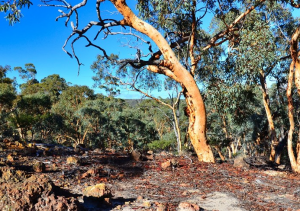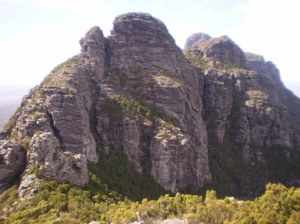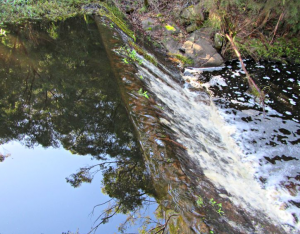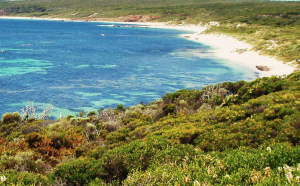POST-CONFERENCE FIELD TRIP
This four-day and three-night tour will encapsulate restoration activities and the natural beauty of the southern regions of southwest Western Australia. Traversing from the jarrah forest on the Darling Plateau to the dryandra woodlands, the botanically diverse Stirling Range National Park and the karri forests in the far south, the tour will highlight many of the states ecosystems and challenges facing restoration practitioners.
Day 1: Perth – Boulder Rock – Pingelly – Dryandra Woodland – Barna Mia animal Sanctuary – Narrogin

Day 1 will see the tour pass across the Canning River, travel up the Araluen Valley and the Darling Scarp before climbing onto the Darling Plateau and travelling through the jarrah (Eucalyptus marginata) forest. Highlights will include Boulder Rock, a large granite outcrop in the jarrah forest, Boyagin Rock and flowering plants of the rare Eucalyptus caesia. Dryandra woodland is an especially scenic area with magnificent powder-bark wandoo woodlands and spectacular wildflowers in spring that once covered much of the Wheatbelt before it was cleared for farming. Dryandra woodland is one of the prime places in the southwest for viewing native wildlife. A predator-proof compound containing core populations of western barred bandicoots, banded hare-wallabies, boodies, bilbies and rufus hare-wallabies has been built to provide a safe environment for breeding. An evening walk through the Barna Mia animal sanctuary, located in the heart of the Dryandra woodland, enables visitors to observe threatened species at close range, whilst also learning about the conservation management principles.
Overnight in Narrogin
Day 2: Narrogin – Wagin – Cranbrook – Stirling Ranges – Boxwood Hill – Albany

Day 2 will see the tour travel to Albany via Wagin, Cranbrook, the Stirling Ranges, Boxwood Hill and the South Coast Highway. This day will provide opportunities to view large scale restoration activities (e.g. at the Wagin Lakes and the Gondwanalink Restoration plantings at Chereninup near Boxwood Hill), botanically diverse areas (e.g. Mount Talyuberlup, Stirling Ranges) and the Albany coastline. The Gondwanalink is an ambitious restoration program aiming to reconnect the landscape from the karri forest of the southwest corner to the woodlands and mallee bordering the Nullarbor Plain. This landscape-scale vision involves individuals and local, regional and national groups working together to achieve reconnected country across south-western Australia in which entire ecosystems, and the fundamental ecological processes that underpin them, are restored and maintained. A further highlight of today will be the Stirling Range National Park, home to over 1500 recorded species of wildflowers and terrestrial orchids that flower in Spring.
Overnight in Albany
Day 3: Albany – Walpole – Northcliffe – Pemberton – Augusta

Day 3 will be spent traveling to Augusta via Walpole, Northcliffe, Pemberton and Stewart Road. The tour will move through the generally low-lying terrain of plantaganet sedimentary deposits (with occasional granite outcrop, dominated by Albany blackbutt (Eucalyptus staeri) and several species of Melaleuca) to granite country, where karri (Eucalyptus diversicolor) and an outlying population of yellow tingle (Eucalyptus guilfoylei) occurs, before returning to low-lying terrain of sedimentary deposits. Highlights will be the tingle forest on the Tree Top walk (Eucalyptus jacksonii, E. guifoylei) with the Giant Tingle Tree, at 24 metres being the largest, living, girthed eucalypt known in the world. Further highlights will be the karri forest and inlet at Coalmine Beach, a pitcher plant swamp (Cephalotus sp) at Walpole, karri forest near Pemberton and Cape Leeuwin Lighthouse and surrounds.
Overnight in Augusta
Day 4: Augusta – Margaret River – Busselton – Perth

On the final day of the tour they will be traveling to Margaret River and Busselton, one of Australia’s premier wine growing regions. Along the Leeuwin Naturaliste Ridge in the Margaret River region, and beneath the karri forest lie more than 100 caves. These caves belong to a series of complex and fragile Karst systems which are landscapes formed by the rapid drainage of water underground. A major highlight of Day 4 will be the restoration efforts within the tuart forest near Ludlow. The Ludlow tuart forest is the only remaining tall tuart forest in the world and is therefore one of the rarest ecosystems left on earth. This will be followed by an example of fauna conservation on private land involving Geocrinia (frog). The final stop on the trip will be Lake Clifton – one of the few places in the world that support thrombolites. Thrombolites are microbialites, which are rock-like structures built by micro-organisms.
Arrive in Perth
